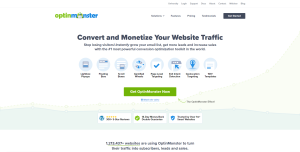Are you looking to unlock the potential of email marketing lead generation? In an era where over 4 billion people are active email users, savvy businesses are leveraging this powerful tool to generate leads, engage potential customers, and ultimately, convert them into loyal buyers. Content writing plays a pivotal role in this process, particularly in creating compelling email content that resonates with your target audience. Mastering the basics of email marketing, building an effective email list, and optimizing your campaigns are key to maximizing lead generation. Stay tuned to discover how to harness email marketing for lead generation, and convert your audience into engaged followers.
”Summary
Email marketing remains a powerful tool for lead generation, captivating the attention of potential customers and converting them into engaged followers and, ultimately, buyers. Despite the rise of social media, email is still a preferred communication method for many, with over 4 billion email users worldwide. Key elements of email marketing include the subject line, relevant and engaging content, and the call to action.
Building an effective email list is crucial, involving identifying your target audience and utilizing opt-in forms to collect email addresses from interested individuals. Creating persuasive content is also vital, requiring understanding of your audience to tailor emails to their interests and needs. The more valuable the content, the higher the chances of lead conversion.
The article further highlights the importance of optimizing email marketing campaigns for effective email marketing lead generation. Strategies include A/B testing, email list segmentation, and content personalization. By focusing on these optimization strategies, email marketing campaigns can be significantly improved.
The Basics of Email Marketing for Lead Generation
Email marketing is a powerful tool for lead generation, capturing the attention of potential customers and turning them into engaged followers and, ultimately, buyers. Understanding the basics of email marketing is the first step towards achieving effective email marketing lead generation.
Why Email Marketing for Lead Generation?
Email marketing remains one of the most cost-effective and efficient ways of reaching potential customers. Despite the rise of social media, email continues to be a preferred mode of communication for many, with over 4 billion email users worldwide. This vast pool of potential customers can turn into a rich source of leads for businesses savvy enough to exploit email marketing.
Key Elements of Email Marketing
Firstly, you need to understand the key elements involved in email marketing lead generation. This includes the subject line, which should be enticing enough to prompt the recipient to open the email. The content of the email should be relevant, engaging, and provide value to the recipient. The call to action (CTA) is equally important as it guides the recipient on what to do next – be it visiting your website, purchasing a product, or subscribing to your blog.
Understanding Your Target Audience
Another fundamental aspect in email marketing for lead generation is understanding your target audience. Knowing their interests, needs, and behavior can help you craft personalized and impactful emails that resonate with them, thereby increasing the chance of conversion.
In conclusion, email marketing, when done correctly, can be an effective lead generation tool. The first step is understanding its basics, including the importance of engaging content, the role of the CTA, and the significance of knowing your audience.
Building an Effective Email List for Lead Generation
Building an effective email list is a critical step in email marketing lead generation. It is the backbone of your email marketing strategy, determining who receives your messages and how likely they are to convert into leads. This process involves several key steps, which we will discuss in detail.
Identifying Your Target Audience
Before you start collecting email addresses, it’s crucial to define your target audience. These are the people most likely to be interested in your products or services. Consider factors such as age, location, interests, and behavior. For example, if you’re a fitness trainer specialized in weight loss, your target audience might be individuals seeking to shed some pounds and lead a healthier lifestyle.
Utilizing Opt-In Forms
Once you’ve defined your target audience, the next step is to collect their email addresses. One of the most effective ways to do this is through opt-in forms. These are forms that visitors to your website voluntarily fill out, providing their email address in exchange for something of value. This could be a free ebook, a discount code, or access to exclusive content. Opt-in forms are a great way to ensure that the people on your email list are genuinely interested in what you have to offer, thus boosting your chances of successful email marketing lead generation.
There are several types of opt-in forms you can use, including pop-ups, slide-ins, and fixed forms on your website. The choice depends on your website design and your audience’s preferences. For instance, if you run a blog, a fixed form at the end of each post might work best. On the other hand, an e-commerce site might benefit more from a pop-up form offering a discount code to first-time customers.
Crafting Compelling Email Content that Converts
Creating persuasive email content is crucial in email marketing lead generation. This involves understanding your audience, creating attention-grabbing subject lines, and delivering valuable content that spurs your readers to take action.
Understanding Your Audience
One of the fundamental steps in creating compelling email content is understanding your audience. Knowing their interests, needs, and pain points can help you tailor your emails to address these concerns. For example, if your target audience is young professionals looking for career advancement, your emails could provide tips on improving skills or industry-relevant news. This approach ensures that your content resonates with your audience, enhancing the chances of lead generation.
Creating Attention-Grabbing Subject Lines
The subject line is the first thing your audience sees, and it’s often the determining factor in whether they open your email or not. Therefore, it’s critical to create subject lines that capture attention. It could be a question, a teaser, or a bold statement, as long as it’s relevant and sparks curiosity. For instance, a subject line such as “Secrets to Boost Your Career” can be an effective teaser to young professionals seeking career growth.
Delivering Valuable Content
Effective email content not only grabs attention but also delivers value to the reader. It could be insights, tips, or exclusive offers; the aim is to provide content that your audience finds beneficial and prompts them to engage further with your brand. Remember, the ultimate goal is to encourage your readers to take action, such as signing up for a webinar, downloading an eBook, or even making a purchase. The more valuable your content, the higher the chances of converting leads.
Optimizing Email Campaigns for Maximum Lead Generation
Optimizing your email campaigns is vital for successful email marketing lead generation. It involves fine-tuning various elements of your emails and campaigns to ensure they are as effective as possible in generating leads.
The Importance of A/B Testing
A key component of optimization is A/B testing. This involves sending two different versions of an email to separate portions of your list to see which performs better. For example, you might test different subject lines, email content, or call to action placements. The version that generates more leads is the one you would use for your wider campaign. This can significantly boost your email marketing lead generation efforts by ensuring that your emails are as effective as possible.
Segmentation and Personalization
Segmenting your email list can also help optimize your campaigns. This involves dividing your email list into different categories, or segments, based on criteria such as past purchases, geographic location, or how they joined your list. You can then tailor your emails to the specific interests and needs of these segments, which can improve engagement rates and lead generation.
Personalization is another effective strategy. This can involve something as simple as including the recipient’s name in the email, or more complex tactics like sending emails based on a person’s past behavior or preferences. Personalized emails are more likely to be opened and clicked on, leading to higher lead generation.
By focusing on optimization strategies such as A/B testing, segmentation, and personalization, you can significantly improve the effectiveness of your email marketing lead generation campaigns.
Conclusion
Indeed, the prowess of email marketing for lead generation is undeniable. With billions of email users globally, this platform provides a fertile ground to foster engagement, conversion, and ultimately, customer loyalty.
Building an effective email list and creating highly persuasive, value-packed content are crucial steps towards leveraging email for lead generation.
To further enhance your email marketing lead generation, optimization strategies such as A/B testing, email segmentation, and personalized content should not be overlooked.
So, whether you’re a solopreneur, a business, or an agency, harness the power of email marketing and watch your lead generation efforts soar to new heights.

